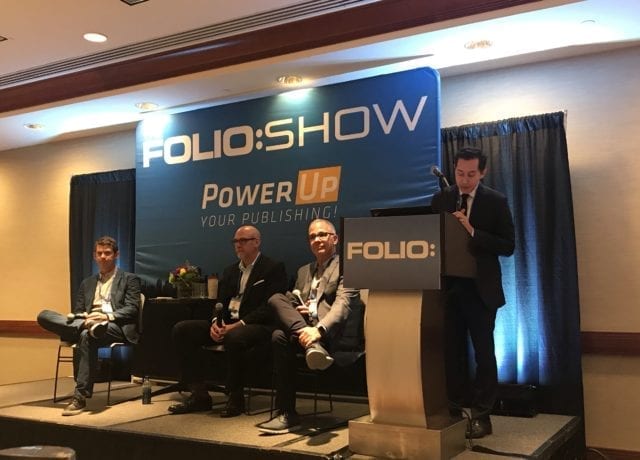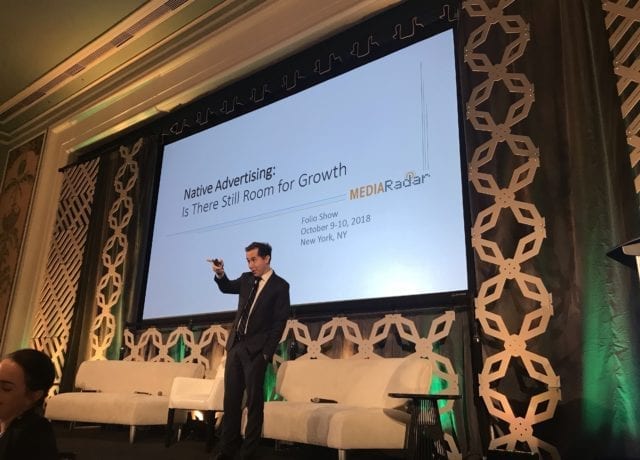By Todd Krizelman
We were honored to attend The Folio: Show last Tuesday, October 9th and Wednesday, October 10th. At this lively event, we were joined by some of the publishing industry’s most notable media partners and experts.
The 2018 program could have been the most dynamic yet – two days of sessions and keynotes guided attendees through the fast-paced and ever-changing world of media and where it’s heading. While publishing industry leaders discussed many different themes from content creation to marketing, audience engagement, and revenue growth, there was one major motif throughout: native advertising.
Native used to be the hottest trend in online advertising. It was a high CPM ad unit and was extremely popular with marketers. Even Google loved it. However, recently, its expansion has slowed. Is there still room for native to grow?

MediaRadar CEO, Todd Krizelman, hosted two panels at The Folio: Show in response to this question. They focused on what publishers should do when it comes to native buying in order to identify native advertising and win those types of advertising opportunities. The panelists all spoke actively about the opportunities and challenges with native in 2018.
The panels included Jeremy Elias, Creative Director from The Atlantic, Annie Granatstein, Head of WP BrandStudio at The Washington Post, Bryan Kinkade, VP, Publisher at Afar Media, and Adam Ochman, VP, Head of Content at The Foundry @ Meredith Corporation.
6 Essential Takeaways from The Folio: Show (2018):
1. Direct to client wins more business for publishers
While Annie Granatstein, Head of WP BrandStudio, said that The Washington Post’s ratio of agency buys to direct client buys was 50/50, she was the outlier. The other panelists revealed that more of their business was actually garnered from clients directly rather than through an agency. Adam Ochman, VP, Head of Content, The Foundry @ Meredith Corporation, announced that “60% of our business originates from the brand directly.” Bryan Kinkade, who leads sales at a niche travel magazine and website that appeals to adventure travelers, reported an even higher percentage. He noted that Afar Media “wins 90% of their business directly from their clients.
2. There are benefits to pitching directly to clients
Every panelist thought that it was easier to connect with the client whenever possible. There is often a “much, much better understanding” of what business needs are when speaking directly with a client. Feedback was that the agencies are time-strapped and less plugged-in. A few panelists also noted that they wanted to take a big idea directly to their client to make sure it was really heard.
These benefits should signal to publishers to experiment more with direct client interaction, especially when it comes to native advertising. Messaging in native is a little more nuanced and, as a result, may be harder to interpret. Before creation, it would help to speak with a client in person, clarifying ideas or answering any concerns, to better understand that brand’s value and their desired ad messaging.
3. RFPs for branded content are not dead, but they do have drawbacks
Panelists still use RFPs for branded content. For example, “95% of The Foundry business originates from RFPs (the RFP can come from the brand or the agency),” notes Adam Ochman.
While RFPs aren’t dead, some panelists like Jeremy Elias from The Atlantic do notate some drawbacks, such as being a poor fit for native advertising. Elias also argued that “everyone has to respond within 24-72 hours from receiving the RFP” and, since most branded content projects are customized and quite involved, having just three business days isn’t long enough to come up with a great pitch.
Reports from JPD Financial, Inc., Content Marketing Institute, and Convince&Convert also list the disadvantages of using RFPs:
- They take up too much time, only establishing tasks and not goals, and don’t even stick in brands’ or agencies’ minds
- They dilute a brand’s uniqueness
- They’re inherently non-collaborative and don’t produce a real business relationship
- They’re rigged, deciding the rules, and will cut margins
- They’ll send the wrong message about a company and undermine its “sellability”
- They’re receiving lower response rates from agencies now
Innovation is king in native advertising, the conduit to distribute branded content. Publishers should probably not waste their time with RFPs, then, if a request for a proposal tends to strip a brand of its uniqueness and “sellability” and also cuts its margins.
Native ads are already involved, as Elias mentioned. So, why take up more of your time producing a RFP, which is both time-consuming and non-collaborative?
4. RFPs are not declining, but the firms receiving them are
Some of the panelists feel like there are fewer RFPs. However, no one could explain why.
Later in the evening, a dozen media buyers at major agencies answered the same question. In this room of buyers, there was a refreshing and specific consensus on this query.
They thought that the number of RFPs is not declining, but that the number of firms receiving them is. There is a decided affinity towards those firms that can offer “1-Stop Shopping” for branded content. They want to work with a publisher, who has the capacity to deliver a unified solution across media formats (desktop, mobile, email, experiential). In short, agencies are handing over more of their budget to a smaller number of publishers.
Publishers, who can deliver native ads across multiple media formats, have an advantage. Competition between publishers is high. RFPs for branded content are already receiving lower response rates and, now, media buyers are saying that firms are cutting down the number of opportunities for publishers to win business even more.
5. Few media firms can stand out when it comes to branded content
The panelists agreed that they do not differentiate much from each other (a hard lesson to learn) – they all offer a low price when it comes to branded content. But, there was wasn’t much else that was concrete. Audience, brand safety, and creative execution are the primary ingredients in branded content.
If a publisher can stand out from its competition in terms of producing branded content, then, it will probably win more business.
The Meredith Corporation, for instance, has at least one element that makes it unique. It has developed competency in making its content “shoppable.” For example, inside its online recipes would be a link to where a consumer could buy the ingredients. Publishers should be aim to be more innovative like Meredith.
6. Native ad campaigns are still successful
The native marketing for Colin Kaepernick led to increased store traffic and higher online sales. Barron’s reported that Nike saw a 31% increase in sales the week after that announcement.
So yes, native matters. It continues to produce positive results.
It’s vital that you know how to gauge the success of your native ad campaigns. You don’t measure native campaign success using impressions or clicks. But, there will be metrics and a report card at the end of the flight. There are also measures for gauging perception and awareness before and after a campaign. Several mentioned using Catalina or iRI for measuring CPG sales in supermarkets.
The ability to collect, aggregate, and calculate this data gives you insights into what about your native campaign is working as well as what can be improved upon.
Conclusion
Native advertising is still successful, despite its growth slowing recently. That’s why it’s important for publishers to identify opportunities with native in 2018. They should focus on direct client over agency interaction, cut their use of RFPs, deliver across multiple media formats, and find more unique ways to produce native ads that will make them stand out from their competition.
To get more of an in-depth analysis of this native advertising trend, be sure to read our most recent trend report.



